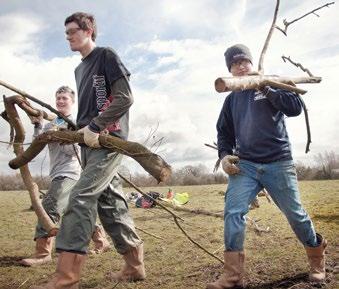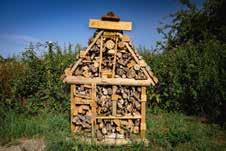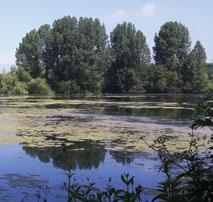Working together in Wiltshire







The Hills Group has played an active part in Wiltshire life for more than 100 years. It has demonstrated its commitment to the communities it serves and it is the company’s particular dedication to Wiltshire’s wildlife that we celebrate here.

The Hills Group has been an inspiration to all those working to protect and restore Wiltshire’s natural environment for its local communities. Its funding has made it possible to purchase special wildlife sites, improve habitat for wildlife, facilitate public enjoyment and appreciation of the natural environment and increase the knowledge and understanding of the natural world among children.
Wiltshire Wildlife Trust (WWT) is just one of many organisations to have benefited from The Hills Group’s support through the Landfill Communities Fund, and through the direct generosity of the company itself, helping us to achieve our vision of a sustainable future for wildlife and people.
with
We are very lucky to have worked in partnership with The Hills Group since 1990. This collaboration has recently reached a major milestone with the total amount given by the company to the Trust over the years exceeding £9 million in 2022. This tremendous landmark in the Trust’s history is a clear sign of The Hills Group’s generosity and the seriousness of its respect for Wiltshire, its natural environment and people.
The continuing support from The Hills Group has been a huge blessing in recent years, as we have had to navigate through uncertain times caused by the Covid pandemic and economic turbulence. Without the belief shown in our work by The Hills Group, we could not have achieved the successes of which we are so proud.
We have highlighted just some examples of how the remarkable support from The Hills Group has resulted in the Trust achieving key outcomes which improve habitats and encourage more people to enjoy nature and live more sustainable and enriching lives.






 and people.
Mike Hill, Chief Executive, The Hills Group
Cover: Eurasion otter, WWT Images (clockwise): Chairman of The Hills Group, Alan Pardoe, opening the new Brockbank Centre at Langford Lakes with Chairman of WWT Mark Street; accompanied by The Hills Group Chief Executive Mike Hill, Deputy Lord Lieutenant of Wiltshire Lord Talbot, WWT Chief Executive Gary Mantle and Trustees. WWT Mike Hill The Hills Group Lower Moor vegetable patch Emma Kirkup
and people.
Mike Hill, Chief Executive, The Hills Group
Cover: Eurasion otter, WWT Images (clockwise): Chairman of The Hills Group, Alan Pardoe, opening the new Brockbank Centre at Langford Lakes with Chairman of WWT Mark Street; accompanied by The Hills Group Chief Executive Mike Hill, Deputy Lord Lieutenant of Wiltshire Lord Talbot, WWT Chief Executive Gary Mantle and Trustees. WWT Mike Hill The Hills Group Lower Moor vegetable patch Emma Kirkup
Images (opposite clockwise):
Tawny owl
WWT
WWT
 Snakes head fritillary Stephen Davis
Buff-tailed bumblebee
Jon Hawkins | Surrey Hills Photography
Helen Haden
Hurdle making
Wellbeing/Forest School Area at Bay Meadows
Snakes head fritillary Stephen Davis
Buff-tailed bumblebee
Jon Hawkins | Surrey Hills Photography
Helen Haden
Hurdle making
Wellbeing/Forest School Area at Bay Meadows



Taking a broader approach to management of the countryside and working across large areas of land, known as working at a landscape scale, is fundamental to enabling the adaptation of our natural environment to the effects of climate change.

The Hills Group has made a major contribution to facilitating this approach on Trust sites and within the farming and landowning community. Vital funding from the company has helped the Trust create nine new nature reserves, providing areas rich in wildlife and space for people to enjoy the outdoors and get closer to nature.
Bay Meadows is a strategically important wildlife corridor between Ogbourne Maisey and Marlborough, purchased by Wiltshire Wildlife Trust in 2021, thanks to the help of funding from The Hills Group and the National Lottery Heritage Fund. A programme of work is underway to restore the floodplain meadows into a better habitat for species such as water vole and brown trout, and for pollinators. The planting of thousands of bulbs of the rare snakes head fritillary will produce a colourful spring display for visitors to enjoy for years to come. Hundreds of new hedgerow plants and trees will provide a haven for wildlife and a circular walk will allow easy access to nature. Alongside habitat enhancements, a comprehensive community engagement programme includes a new wellbeing/forest school area and wild play areas.
Since 1990, Hills has supported the Trust’s work in the Braydon Forest area to the west of Swindon. Thanks to their continued support, the Living Landscape which is managed by the Trust is one of the richest wildlife areas in the UK. Hills’ support
at High Penn Wood with the help of 100 volunteers.
n The planting of fruit trees at Sandpool Farm, including rare Wiltshire varieties of apple, plum, cherries, pears, quince and crab, as well as some nut trees like walnut and cobbs.
Four lakes, 25 acres of wetland, 13 acres of reed bed and 600 metres of the River ylye. Wet grassland has been reated, which has attracted ‘Schedule 1’ birds such as barn owls reed. Support has also helped us create a new visitor centre and education facilities at Langford Lakes nature reserve near Salisbury.
n The establishment of The Braydon Forest Countryside Management Project to monitor and liaise with local landowners and farmers to help protect the local curlew population. Curlew are now on the UK Red List of species of greatest concern, with breeding pairs estimated to have fallen from 23 to just five in the Braydon Forest between 1994 and 2019.

The return of otters to Wiltshire after 24 years of hard work, with regular otter sightings at Lower Moor nature reserve after the construction of 44 artificial holts along rivers to provide sanctuary.
n The completion of a project to improve and enhance existing dragonfly sites and create new open water habitat at Lower Moor nature reserve, with hairy dragonflies and downy emeralds sighted in recent years.
n Around 180 farmers and landowners managing their land sympathetically for wildlife and people supported by WWT; 37 farmers and landowners have been supported through the Magnificent Meadows project match funded by The Hills Group – including three who have taken green hay from our reserves to create new wildflower-rich pasture.
n The growth of our farms at Coombe Bissett
n The extension and improvement of car parks in sympathy with the nature reserves they serve has improved access and enabled more people to safely benefit from nature.
Down, Blakehill and Lower Moor. Over 720 ha. of grassland requires careful grazing to ensure that biodiversity is protected and enhanced. Thanks to continued support, we have over 750 cattle and sheep, and the necessary staff, equipment and housing to run a successful farming operation.

Image (above): What lives in the water at Lower Moor? Ryan Tabor WWT

Images (opposite): Sheep at Coombe Bissett Down
Curlew David Kjaer
Louise Hartgill
Image (left): Brown hare

Elliot Neep
Image (left): Brown hare Elliot Neep
Images (opposite clockwise): Installing bug stumps at Langford Lakes
Images (opposite clockwise): Installing bug stumps at Langford Lakes
WWT
WWT
Kingfisher
Kingfisher
Malcolm Brown Butterfly bank at Coombe Bissett Down
Volunteers at Distillery Meadows Ryan Tabor
Volunteers at Distillery Meadows Ryan Tabor
Malcolm Brown Butterfly bank at Coombe Bissett Down
WWT
WWT
More people than ever before have recognised the importance of spending time in nature to benefit their learning, health and wellbeing. While it is wonderful to see more visitors at Trust nature reserves and more educational activities taking place, this inevitably means more management to keep reserves safe and minimise the impact on wildlife.
Support from The Hills Group has not only given the Trust the resources to face these challenges head on, but also the confidence to develop and grow as an organisation and the courage to work in new and innovative ways. The partnership has enabled the Trust to create a greener Wiltshire, including encouraging communities to live more sustainably.
By demonstrating its confidence in the Trust’s ability to deliver, The Hills Group’s support has also enabled the Trust to secure millions of pounds from other funders to support our projects and core activities.
n The bi-annual Wiltshire Wildlife magazine
is distributed to members in full-colour print and/or digital format, helping to spread the word about wildlife, environmental issues and sustainable lifestyles.
n A library of more than 15,000 images of
nearly 60 wildlife sites provides a priceless resource.


n Hundreds of volunteers of all ages are equipped and trained to help deliver our vision, building social cohesion and delivering vital conservation work.
n 2,500 trees have been planted to soften the effects of Ash Dieback at High Penn Wood, with a programme of further tree planting in place if and when ash trees are felled at other woodland nature reserves for public safety.


The Hills Group has made a major contribution to ensuring Wiltshire is a county fit for our children to grow up in, and for them to become good environmental citizens of the future, caring for their surroundings.


n In 2020, with support from The Hills Group and other donors, we were able to open our second Care Farm named 'The Willows' at Mill Farm. Our first, Lakeside Care Farm at Lower Moor, also continues to thrive with full occupancy. They offer therapeutic activities in nature conservation, farming, horticulture and animal care for children and young people with additional needs.
n In one year alone, the Waste Education Team engaged 5,598 students from 36 schools and 23 preschools and youth groups in meaningful recycling sessions such as ‘Trashion Shows’ and community waste prevention campaigns.
n Solar panels demonstrate renewable energy at Langford Lakes Education Centre.
n Thousands of Wiltshire’s children can experience their natural environment through a chain of flower-rich meadows at Lower Moor nature reserve.

n Over 1,000 school children in Westbury designed cotton bags, supplied by The Hills Group, with environmental messages they had learnt through the Trust’s Recycle for Wiltshire waste programme, which was funded by Wiltshire Council
n Hundreds of headteachers, teachers and governors can now embed sustainability principles in their schools’ ethos through conferences, advice sessions and Your Guide to Becoming a Sustainable School.


Elm Tree Court, Long Street Devizes, Wiltshire, SN10 1NJ 01380 725670
info@wiltshirewildlife.org

‘Like’ us on Facebook.com/WiltsWild
Follow @WiltsWildlife on Twitter

Follow us on Instagram –www.instagram.com/wiltswildlife www.wiltshirewildlife.org

The Hills Group Limited
Wiltshire House, County Park Business Centre, Shrivenham Road, Swindon, SN1 2NR 01793 781200
info@hills-group.co.uk
'Like' us on Facebook.com/HillsGroup
Follow @HillsGroup on Twitter
Photo credits left to right:
Lakeside Care Farm
Dean Sherwin
Orange tip on bluebell

Stephen Davis
WWT reserve volunteers Dean Sherwin
Langford Lakes Emma Kirkup
Follow us on Instagram –www.instagram.com/the_hills group www.hills-group.co.uk WWT Charity number 266202 WWT company registration number